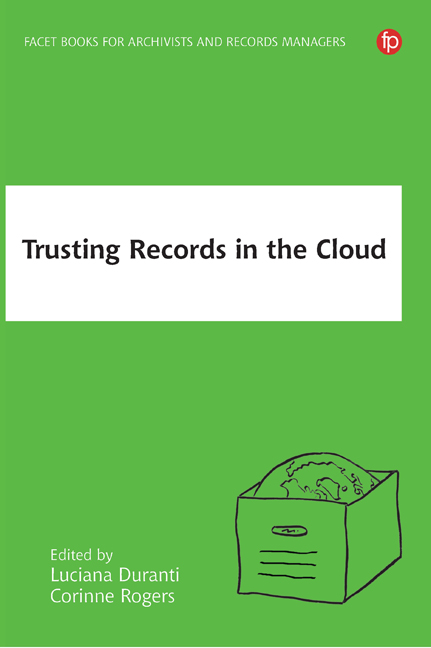Book contents
- Frontmatter
- Contents
- List of Figures and Tables
- Contributors
- 1 Introduction
- 2 The Cloud – Challenges and Issues
- 3 Open Government
- 4 Citizen Engagement
- 5 Strategies, Methods and Tools Enabling Records Governance in a Cloud Environment
- 6 Retention and Disposition
- 7 Authentication
- 8 Intellectual Control
- 9 Exploring Digital Preservation in the Cloud
- 10 Cultural Heritage – Indigenous Perspectives
- 11 The Role of the Records Professional
- 12 Education
- Appendix 1 InterPARES Trust Terminology
- Appendix 2 Products of InterPARES Trust Research
- Index
4 - Citizen Engagement
Published online by Cambridge University Press: 24 September 2019
- Frontmatter
- Contents
- List of Figures and Tables
- Contributors
- 1 Introduction
- 2 The Cloud – Challenges and Issues
- 3 Open Government
- 4 Citizen Engagement
- 5 Strategies, Methods and Tools Enabling Records Governance in a Cloud Environment
- 6 Retention and Disposition
- 7 Authentication
- 8 Intellectual Control
- 9 Exploring Digital Preservation in the Cloud
- 10 Cultural Heritage – Indigenous Perspectives
- 11 The Role of the Records Professional
- 12 Education
- Appendix 1 InterPARES Trust Terminology
- Appendix 2 Products of InterPARES Trust Research
- Index
Summary
Introduction
This chapter explores the notion of ‘citizen engagement’ from a socio-cultural and user-centred perspective. It does so by drawing on a set of InterPARES Trust (hereinafter ITrust) studies which looked at the relationship between records (understood both in a specific sense and as information objects), record systems (including any technologies used to manage all kinds of data and information) and the users of such records and systems (e.g. creators, subjects, administrators, curators, end-users) with an emphasis on the kind of human engagement, or participation, that arises from, and gives shape to, such a relationship. The contributions gathered in this chapter try to answer questions such as:
• How do people perceive born-digital objects? What makes them trust the records and the institutions in charge of them? (Questions addressed in EU27 User Perceptions of Born-Digital Authenticity (Bunn et al., 2016));
• How has citizens’ communication with the government changed over time? Has the nature of patents and petitions – two very common legal genres enabling the interaction between people and institutions – shifted in the digital age? (Questions addressed in NA13 Patents, Petitions, and Trust (Hohmann, 2016; Foscarini, 2019);
• How are open government initiatives and civic technologies changing society and the way citizens participate in public matters? Questions addressed by NA08 The Implications of Open Government, Open Data, and Big Data on the Management of Digital Records in an Online Environment (Suderman and Timms, 2016); and EU05 Models for Monitoring and Auditing of Compliance in the Flow from Registration to Archive in e-Register (Strahonja, 2018);
• Can social media be used by local governments to increase citizen trust? What can we learn about the administration of social media that results in an increase in trust in government? (Questions addressed in NA05 Social Media and Trust in Government (Franks, 2016));
• Are the users taken into account when appraising an institutional website? What can we learn about citizen engagement through measuring visitor interactions with such websites? (Questions addressed in EU25 Using Web Analytics in Appraisal of Records on the Foreign Ministry of Israel Website (Schenkolewski-Kroll and Tractinsky, 2016)).
- Type
- Chapter
- Information
- Trusting Records and Data in the Cloud , pp. 65 - 96Publisher: FacetPrint publication year: 2018
- 1
- Cited by

